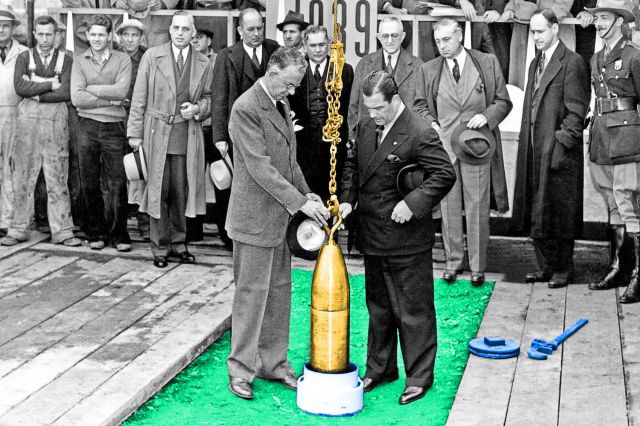
Paul Revere and Samuel Adams Time Capsule, 1795–2015
On July 4, 1795, American patriot Paul Revere, Massachusetts Governor Samuel Adams, and Revolutionary War Colonel William Scollay created what is considered the world’s oldest known time capsule. At a ceremony marking the completion of the Massachusetts State House, they placed items underneath the cornerstone of the building. It remained there until 1855, when it was dug up during emergency repairs. Then-Governor Henry Gardner added more objects to the collection, and the capsule was eventually reburied. During repairs in 2014, the time capsule was retrieved again, and its contents were finally revealed. It included coins minted as early as 1667, an engraved silver plaque, and a medal depicting George Washington. Following an exhibit of the artifacts at Boston’s Museum of Fine Arts, the time capsule was replaced in the state house.

The Century Safe, 1876–1976
In his book Time Capsules: A Cultural History, William E. Jarvis identifies the Century Safe as the first modern time capsule, due to its specified reopening date. Magazine publisher Anna Deihm chose the items — including photos of government leaders and inkstands belonging to famous writers — as part of the 1876 Philadelphia Centennial Exposition. She enclosed them in a 5-foot-tall iron safe, which she gave to the U.S. House of Representatives to reopen in 1976. The huge, heavy box ended up stored on the Capitol’s east portico for the next eight decades. When the time came to open it during the nation’s bicentennial, no one remembered where the keys were, and a locksmith had to crack it open.

Westinghouse Time Capsule, 1938–6938
George E. Pendray coined the phrase “time capsule” when he coordinated the Westinghouse Time Capsule at the 1939 New York World’s Fair. The 7.5-foot-long, tube-shaped container was made of the company’s new copper alloy, Cupaloy, designed to withstand burial for 5,000 years. Pendray solicited suggestions for its contents from leading thinkers, and ended up with a mix meant to represent life in the 1930s, ranging from a can opener and textiles to seeds. Microfilms of written material and newsreels completed the contents. The capsule was buried on September 23, 1938, on the World’s Fair grounds, where it remains today. Westinghouse added a second time capsule to the vault during the 1964 World’s Fair. The items are intended to be dug up around 6938.
More Interesting Reads

Crypt of Civilization, 1940–8113
In 1936, inspired by the discoveries of ancient Egyptian tombs in the 1920s, Oglethorpe University president Thornwell Jacobs imagined a collection of items that would show future archaeologists life in the 20th century. He stipulated that this “crypt of civilization” should be opened in the year 8113, a date he determined by doubling the number of years between what was believed to be the start of the Egyptian calendar (4241 BCE) and 1936, so that his collection would represent the midpoint of world history. Over three years, Jacobs amassed donated items as diverse as dental floss, beer, and an original script of Gone With the Wind, and built an impenetrable chamber on the university’s Georgia campus in which to store them. In May 1940, the crypt was sealed behind a steel door for (almost) all eternity.

Expo ’70 Time Capsule, 1970–6970
The time capsule craze was still going strong in 1970 when the Panasonic Corporation and Mainichi Newspapers assembled two identical capsules during the Japan World Exposition in 1970. The first will remain sealed until 6970, while the second was reopened for inspection in 2000 and is scheduled for regular maintenance every 100 years. Organizers included an extensive selection of Japanese cultural objects, literature, and modern inventions in two large steel cylinders, which were lowered by crane into the ground next to Osaka Castle in January 1971.

Millennium Vault, 2000–3000
Along with the fear of malfunctioning computers, Y2K brought on a wave of interest in time capsules commemorating the 20th century. Organizers in Surrey, U.K., assembled an especially nostalgic collection of objects for Europe’s — and the world’s — largest time capsule vault on the grounds of Guildford Castle. Behind the brick façade, scheduled to be reopened in the year 3000, are a rust-proof Cooper Mini, a Rolls Royce hood ornament, a Sony Walkman, a life-size photograph of World War II-era singer Vera Lynn, and other artifacts. The U.S. had its own — and much smaller — millennium time capsule containing a chunk of the Berlin Wall, Ray Charles’ sunglasses, a Twinkie, and more, due for unearthing in 2100.











